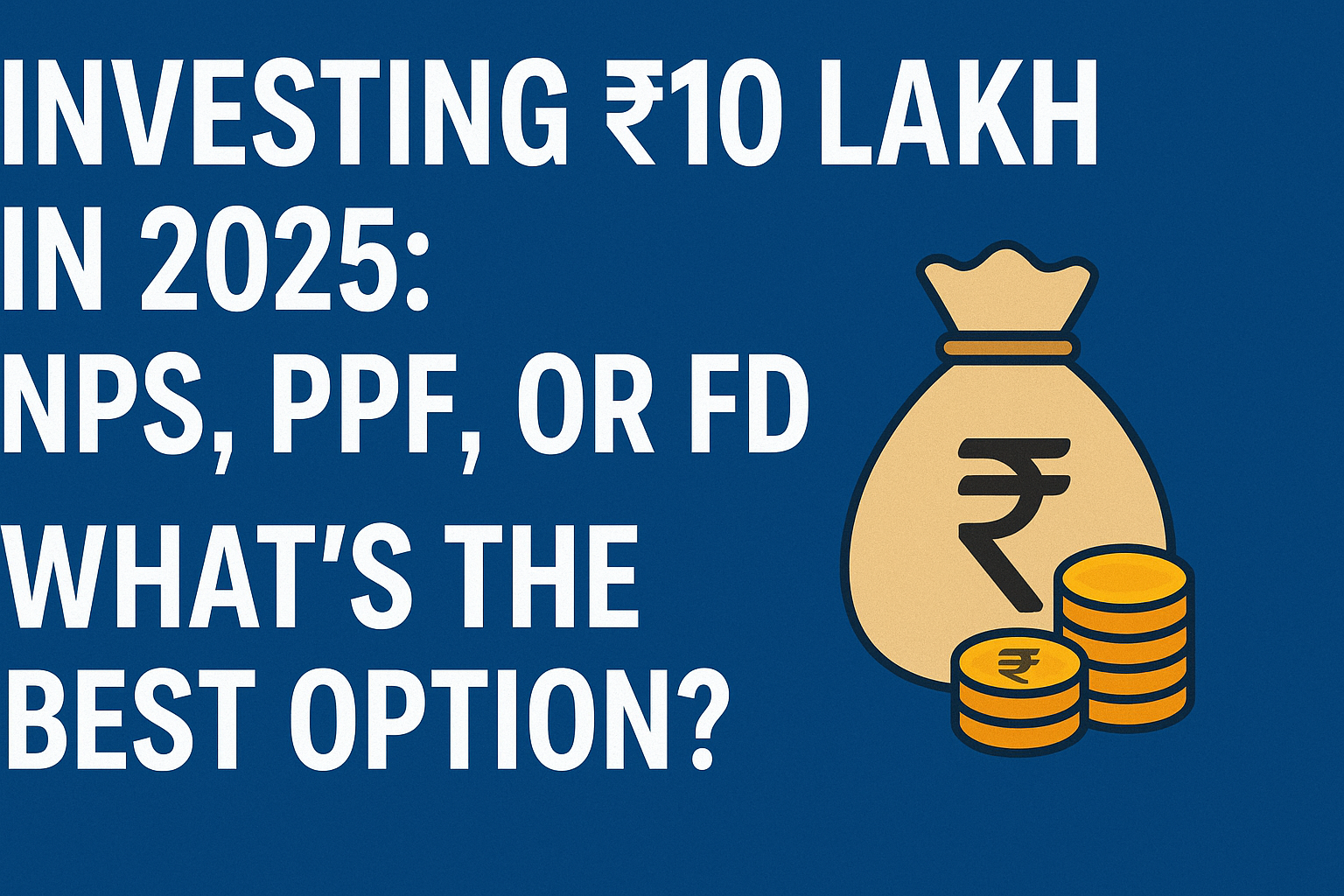Investing ₹10 Lakh in 2025 : Investing ₹10 lakh wisely in 2025 can set the foundation for long-term financial security, stable returns, and tax efficiency. Among the most trusted options in India are the National Pension System (NPS), Public Provident Fund (PPF), and Fixed Deposits (FDs). Each offers unique benefits in terms of returns, safety, lock-in periods, and taxation.
If you’re wondering where to invest your ₹10 lakh in 2025—NPS vs PPF vs FD, this article breaks down each option based on key investment factors to help you make an informed decision.
Understanding the Three Investment Options
1. National Pension System (NPS)
- NPS is a government-sponsored pension scheme aimed at long-term retirement planning invests your money in a mix of equity and government securities.
- Returns: Historically, NPS has delivered 8% to 10% returns depending on the equity-debt allocation.
- Lock-in: Till the age of 60.
- Tax Benefits:
- Up to ₹1.5 lakh under Section 80C.
- Additional ₹50,000 under Section 80CCD(1B).
- Maturity: 60% of the corpus is tax-free; 40% must be used to buy an annuity, which is taxable.
2. Public Provident Fund (PPF)
- PPF is a long-term savings scheme backed by the government, offering tax-free returns and guaranteed interest.
- Returns: Currently at 7.1% per annum (subject to quarterly review).
- Lock-in: 15 years (partial withdrawals allowed after 7 years).
- Tax Benefits:
- Up to ₹1.5 lakh under Section 80C.
- EEE status: exempt at investment, accumulation, and maturity.
- Safety: Government-backed, zero risk.
3. Fixed Deposit (FD)
- FDs are the most traditional used investment option in India. Banks and NBFCs offer FDs with various tenures options.
- Returns: 6.5% to 7.75% in 2025 depending on the bank
- Lock-in: 7 days to 10 years (can be broken with a penalty).
- Tax Benefits:
- Tax-saving FD allows deduction up to ₹1.5 lakh under 80C.
- Interest is fully taxable.
- Safety: Very safe if invested in a reputable bank (covered up to ₹5 lakh by DICGC).
Key Comparison: NPS vs PPF vs FD
Feature NPS PPF FD
- Return Potential 8% – 10% (market-linked) 7.1% (fixed) 6.5% – 7.75% (fixed)
- Risk Level Moderate (market exposure) Very Low (govt. guaranteed) Very Low (bank backed)
- Lock-in Period Till age 60 15 years 5 years (for tax-saving FD)
- Tax Benefit Up to ₹2 lakh (80C + 80CCD) Up to ₹1.5 lakh (80C) Up to ₹1.5 lakh (80C)
- Tax on Returns Partially taxable Fully tax-free Fully taxable
- Liquidity Low Moderate (after 7 years) High (with penalty)
- Where Should You Invest ₹10 Lakh in 2025?
Here’s a breakdown of which investment suits which type of investor and goal:
Also Read : ICICI Bank Home Loan Process 2025: Step-by-Step Guide to Easy Approval
- Your goal is retirement planning.
- You’re comfortable with a long-term lock-in.
- You want to maximize tax savings
- You’re okay with partial taxation at maturity.
- Ideal for: Salaried professionals in their 30s–40s planning for retirement.
- You’re looking for safe, long-term savings with tax-free returns.
- You want a guaranteed, government-backed option.
- You don’t need frequent liquidity.
- Ideal for: Conservative investors, risk-averse savers, and those saving for a child’s education or weddin
- You need capital protection and short to medium-term liquidity.
- You want to avoid market fluctuations.
- You don’t need Section 80C benefits or are okay with taxed returns.
- Ideal for: Senior citizens, retirees, or anyone looking for stable short-term returns.
- Suggested Investment Strategy for ₹10 Lakh
- Rather than choosing one option, you can diversify your ₹10 lakh investment to benefit from each:
- ₹4 lakh in NPS for long-term retirement + tax benefits.
- ₹3 lakh in PPF for safe, tax-free returns.
- ₹3 lakh in a 5-year FD for medium-term goals and capital protection.
- This mix balances risk, return, and liquidity, helping you meet both long-term and short-term financial goals in 2025.
Final Thoughts
All three investment options—NPS, PPF, and FD—are safe, government-backed (or regulated) choices. But they serve different purposes.
If you’re young and saving for retirement, NPS is the best fit.
- For guaranteed, tax-free returns, PPF is unmatched.
- For capital safety and liquidity, especially in the short term, FDs are ideal.
In 2025, investing wisely means not just chasing returns but aligning your money with your financial goals, risk tolerance, and time horizon. A balanced portfolio using all three can offer the best of growth, safety, and tax planning.

